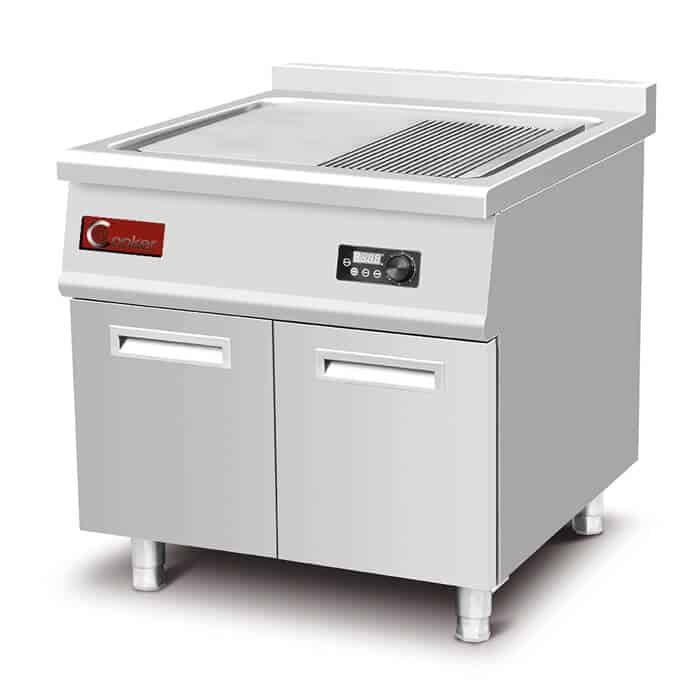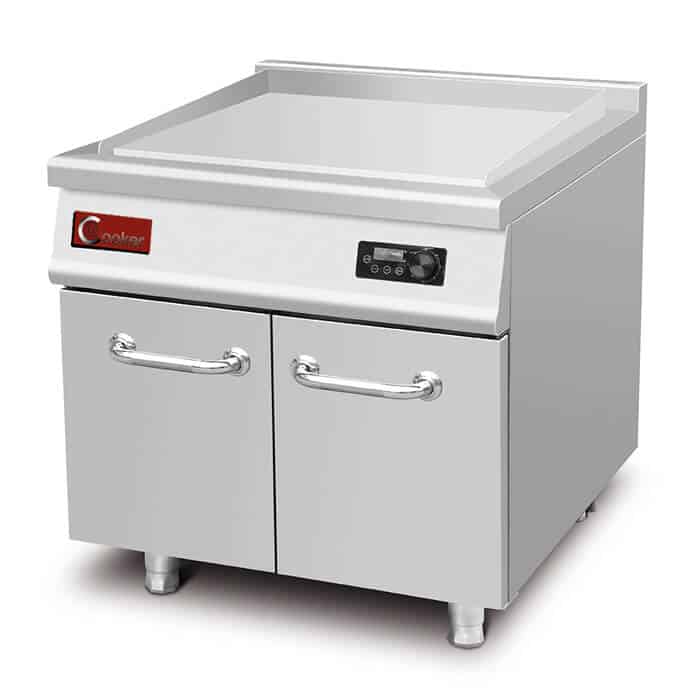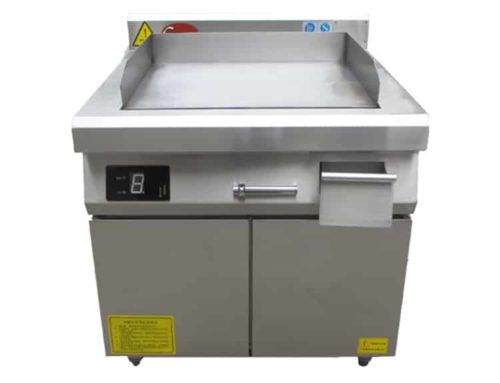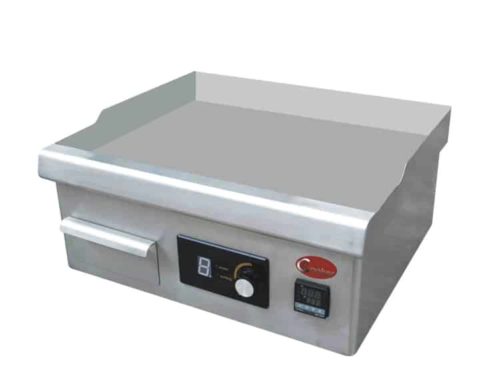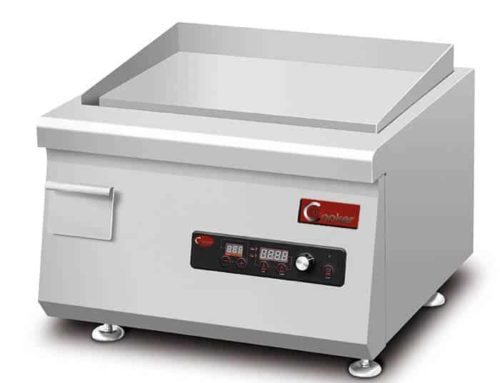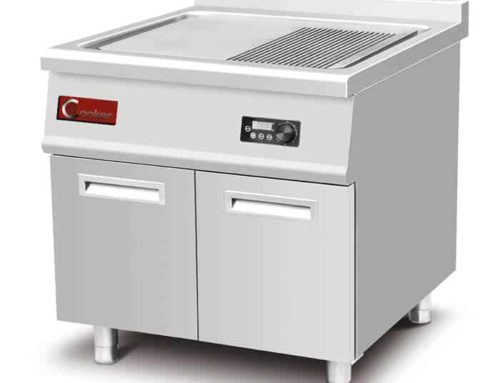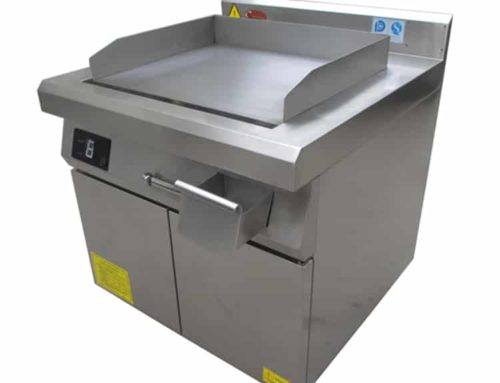Induction Ready Griddle: How Plate Thickness Impacts Heat Retention & Cooking Quality
For an induction ready griddle—especially commercial models like those from AT Cooker—plate thickness is not just a “nice-to-have” feature: it is a make-or-break factor for heat retention, cooking consistency, and long-term durability. Unlike gas or electric griddles (which heat the plate indirectly via flames or coils), induction griddles rely on electromagnetic energy to heat the plate directly. This means the plate’s thickness dictates how evenly heat distributes, how long it retains that heat during cooking, and how well it resists warping under the demands of commercial use.
AT Cooker’s 2024 testing of commercial induction griddles found that plates with insufficient thickness (≤6mm) led to 30% more hot spots, 25% faster heat loss during cooking, and a 40% higher risk of warping after 12 months of daily use. In contrast, their premium induction commercial griddle models—equipped with 8–12mm thick 304# stainless steel or cast iron plates—maintained temperature within ±5°F during peak service, reduced food waste by 18%, and lasted 7+ years without performance degradation.
This comprehensive guide will explore why plate thickness matters for induction ready griddles, how it influences heat retention and cooking quality, how to compare materials (cast iron vs. stainless steel) based on thickness, and how AT Cooker optimizes plate design for commercial kitchens. By the end, you’ll understand exactly why investing in a thick-plate induction griddle is critical for consistent, high-quality results—whether you’re searing burgers, making omelets, or cooking large batches of breakfast hash.
Heat Retention: Thicker = Longer Temp Hold
Cooking Quality: Thicker = Fewer Hot Spots
Materials: Cast Iron > 304# Stainless Steel (Heat Retention)
1. The Science of Plate Thickness: Why It Matters for Induction Ready Griddles
To fully grasp the importance of plate thickness, it’s first critical to understand how induction technology interacts with the griddle plate. Unlike traditional griddles, where heat travels from an external source (flame, coil) to the plate’s surface, induction griddles generate heat within the plate itself via electromagnetic induction. Here’s a simplified breakdown:
How Induction Heats a Griddle Plate
- When the induction griddle is activated, an alternating current (AC) flows through a copper coil beneath the plate.
- This current creates a high-frequency magnetic field (20–50 kHz) that penetrates the griddle plate.
- The magnetic field induces eddy currents (circular electrical currents) in the plate’s metal structure—these currents generate heat as they encounter resistance from the metal.
- The plate’s thickness determines how deeply these eddy currents travel (the “skin effect”) and how much thermal mass the plate has to retain the generated heat.
Key takeaway: A thicker plate has more thermal mass (ability to store heat) and allows eddy currents to distribute more evenly across its structure. This directly translates to better heat retention and fewer hot spots—two factors that define cooking quality on an induction ready griddle.
Thermal Mass: The Foundation of Heat Retention
Thermal mass refers to a material’s ability to absorb, store, and release heat. For an induction ready griddle, a plate with higher thermal mass (thicker) will:
- Absorb more heat during the initial heating phase, even if it takes slightly longer to reach the target temperature.
- Release heat slowly during cooking, maintaining a consistent surface temperature even when cold food is added (a common cause of temperature drops on thin plates).
- Recover heat faster after food is removed, reducing wait times between batches—critical for commercial kitchens during peak service.
AT Cooker’s testing illustrates this clearly: a 10mm thick 304# stainless steel plate retained 80% of its heat 5 minutes after turning off the griddle, while a 5mm plate retained only 45%. For a diner cooking 50+ burgers per hour, this difference means the thick plate stays hot enough to sear each patty consistently, while the thin plate requires frequent power adjustments to avoid undercooked food.
2. How Thickness Impacts Heat Retention: Consistency, Efficiency, and Cost Savings
Heat retention isn’t just about keeping the plate hot—it’s about maintaining a stable temperature that doesn’t fluctuate during cooking. For commercial kitchens, this stability directly impacts efficiency, food quality, and even utility costs. Below are the three key ways plate thickness influences heat retention for an induction ready griddle:
2.1 Consistent Temperature: No More “Cold Zones” or Overheating
Thin griddle plates (≤6mm) have minimal thermal mass, meaning they react quickly to temperature changes—both positive and negative. When you place a cold pan or a batch of raw food on a thin plate, the surface temperature can drop by 50°F or more in seconds, leading to undercooked food. Conversely, when the plate is empty, thin metal can overheat rapidly, risking burnt residues or even warping.
A thicker plate (8mm+) acts as a “heat buffer.” For example, AT Cooker’s 5KW commercial induction griddle features a 10mm thick 304# stainless steel plate. During testing, adding 2kg of cold hash browns to the preheated plate (375°F) caused a temperature drop of only 15°F—enough to cook the hash browns evenly without requiring additional power. A thin-plate griddle under the same conditions dropped to 300°F, resulting in soggy, undercooked potatoes that needed extra time on the griddle.
This consistency is especially critical for menu items that require precise temperatures, like delicate omelets (325°F) or seared steaks (400°F). A thick plate ensures the griddle stays within the ideal temperature range, no matter how many batches you cook.
2.2 Reduced Heat Loss: Lower Energy Consumption
Thicker griddle plates don’t just retain heat better—they also reduce heat loss to the surrounding environment. A thin plate loses heat quickly through its edges and bottom, forcing the induction system to work harder (and use more energy) to maintain the target temperature. A thicker plate, with its greater thermal mass, minimizes this loss by acting as an insulator.
AT Cooker’s energy efficiency data highlights this: their 3.5KW induction griddle with an 8mm plate uses 9.2 kWh of electricity per 8-hour shift, while a comparable thin-plate griddle (5mm) uses 12.7 kWh—nearly 38% more energy. Over a year, this difference translates to $350+ in savings for a single griddle, a significant amount for kitchens with multiple units.
Additionally, the reduced heat loss keeps the kitchen cooler—a secondary benefit that improves staff comfort and reduces the load on HVAC systems, leading to even more cost savings.
2.3 Faster Recovery Between Batches
Commercial kitchens don’t have time to wait for a griddle to reheat between batches. A thick plate’s thermal mass allows it to recover heat far faster than a thin plate. For example:
- AT Cooker’s 12mm cast iron induction griddle takes 45 seconds to recover from 350°F to 375°F after removing a batch of burgers.
- A thin 5mm stainless steel griddle takes 2 minutes 15 seconds to recover to the same temperature under identical conditions.
During a busy breakfast rush, this difference can mean serving 10–15 more customers per hour. A diner in Chicago using AT Cooker’s cast iron induction griddle reported: “We used to have a line out the door waiting for the griddle to reheat. Now, we can cook back-to-back batches of pancakes without waiting—our ticket time dropped by 20%.”
“We switched from a thin-plate electric griddle to AT Cooker’s 10mm thick induction ready griddle last year, and the energy savings were immediate. Our monthly electricity bill for the griddle went from $180 to $120, and we no longer have to throw out undercooked eggs because the plate stays hot. The thick plate also cleans easier—no burnt spots from uneven heating. It’s one of the best investments we’ve made for our kitchen.”
3. How Thickness Improves Cooking Quality: Evenness, Searing, and Durability
Heat retention is only half the story—plate thickness directly impacts the quality of the food you cook. From perfectly seared meats to evenly cooked vegetables, a thick plate ensures consistent results batch after batch. Below are the four key ways thickness elevates cooking quality on an induction ready griddle:
3.1 Eliminating Hot Spots: Even Cooking Every Time
Hot spots—areas of the griddle that are significantly hotter than others—are the bane of any commercial kitchen. They cause food to burn in some spots while remaining undercooked in others, leading to wasted ingredients and inconsistent customer experiences. Thin plates are particularly prone to hot spots because eddy currents (the source of induction heat) tend to concentrate near the plate’s edges or directly above the induction coil.
A thicker plate distributes these eddy currents more evenly across its entire surface. AT Cooker’s engineering team uses computer-aided design (CAD) to optimize plate thickness for their induction griddles, ensuring the magnetic field penetrates uniformly. Their 8mm thick 304# stainless steel plate, for example, has a temperature variation of only ±3°F across its entire 418×398mm cooking surface—far below the ±15°F variation of thin-plate griddles.
This evenness is transformative for dishes like breakfast hash, where potatoes, onions, and peppers must cook at the same rate. A line cook at a hotel using AT Cooker’s griddle noted: “Before, I’d have to stir the hash constantly to avoid burning the edges. Now, I can spread it out and walk away for a minute—everything cooks evenly, and the texture is perfect every time.”
3.2 Enhancing Searing and Browning: Maillard Reaction Perfection
Searing meats or browning vegetables requires a hot, stable surface temperature—typically 375°F–450°F. A thin plate often drops below this critical temperature when food is added, failing to trigger the Maillard reaction (the chemical process that creates rich, browned flavors). A thick plate, with its superior heat retention, maintains the high temperature needed for proper searing.
AT Cooker’s 5KW induction griddle with a 12mm cast iron plate excels at searing. Testing showed it could maintain 400°F while searing 4 8-oz burgers at once, creating a crisp, flavorful crust without burning. A thin-plate griddle under the same conditions dropped to 325°F, resulting in pale, gray burgers with no distinct crust.
For restaurants that specialize in grilled or seared dishes, this difference is a competitive advantage. A steakhouse in Las Vegas using AT Cooker’s cast iron induction griddle said: “Our customers come for the sear on our ribeyes. The thick cast iron plate gives us the same results as a commercial gas grill, but with better consistency and no gas fumes.”
3.3 Retaining Moisture: Juicier Food, Better Flavor
When a griddle plate drops in temperature after food is added, it doesn’t just undercook the exterior—it also causes the food to release more moisture as it cooks slowly. This leads to dry, tough meats and soggy vegetables. A thick plate’s stable temperature cooks food quickly and evenly, sealing in moisture and preserving flavor.
AT Cooker’s testing compared two induction griddles: one with a 10mm plate and one with a 5mm plate. Both were set to 375°F, and 4-oz chicken breasts were cooked on each. The chicken on the thick-plate griddle retained 18% more moisture than the chicken on the thin-plate griddle—resulting in juicier meat with a more tender texture.
This moisture retention is especially important for delicate proteins like fish or eggs. A café using AT Cooker’s griddle reported: “Our scrambled eggs used to be dry by the time we served them. With the thick plate, they’re creamy and moist—customers keep asking what we changed.”
3.4 Durability: Resisting Warping and Wear
Commercial griddles endure extreme conditions: daily heating/cooling cycles, heavy utensils, and frequent cleaning with abrasive tools. Thin plates are far more likely to warp under these stresses—even a small warp can create uneven cooking surfaces and trap food debris, leading to more cleaning time and reduced lifespan.
A thicker plate is inherently more rigid and resistant to warping. AT Cooker’s 304# stainless steel plates are 8–12mm thick, with reinforced edges to withstand impact from spatulas or pans. Their cast iron plates are even thicker (12–15mm) and seasoned with a protective layer to resist rust and scratches.
Long-term testing by AT Cooker found that their thick-plate griddles had a 70% lower warping rate after 5 years of commercial use compared to thin-plate models. A hotel kitchen manager said: “Our old thin-plate griddle warped after 2 years, and we had to replace it. Our AT Cooker griddle is going on 4 years, and the plate still looks and cooks like new.”
4. Material Matters: How Thickness Works with Different Griddle Plate Materials
Plate thickness doesn’t exist in a vacuum—it works in tandem with the plate’s material to determine heat retention and cooking quality. The two most common materials for induction ready griddles are cast iron and 304# stainless steel, each with unique properties that interact with thickness differently. Below is a detailed comparison:
Cast Iron: The Gold Standard for Heat Retention
Cast iron is naturally ferromagnetic (ideal for induction) and has the highest thermal mass of any common griddle material. A 12mm thick cast iron plate on an induction ready griddle will retain heat longer than a 12mm stainless steel plate, making it perfect for searing or cooking dishes that require extended heat. However, cast iron does have tradeoffs: it takes longer to heat up (10–15 minutes to reach 375°F vs. 5–7 minutes for stainless steel) and requires regular seasoning to maintain its non-stick properties.
AT Cooker’s cast iron induction griddles (e.g., the 5KW AT-CI-G12) feature 12mm thick plates that are factory-seasoned for immediate use. A BBQ joint in Texas using this model said: “We cook 200+ burgers a day, and the cast iron plate keeps up. Even during the lunch rush, we never have to wait for the griddle to reheat—each burger gets the same perfect sear.”
304# Stainless Steel: The Versatile Commercial Choice
304# stainless steel is the most popular material for commercial induction griddles because it balances heat retention, durability, and ease of cleaning. An 8–10mm thick stainless steel plate heats up faster than cast iron, resists corrosion from commercial cleaning chemicals, and doesn’t require seasoning. While it doesn’t retain heat quite as long as cast iron, it still outperforms thin plates by a wide margin.
AT Cooker’s best-selling 3.5KW induction griddle (AT-SS-G08) uses an 8mm thick 304# stainless steel plate with a polished surface for easy wiping. A hotel breakfast buffet using this model noted: “We clean the griddle 10+ times a day—stainless steel wipes clean in seconds, and the thick plate doesn’t scratch. It’s perfect for our high-turnover buffet service.”
Enamel-Coated Cast Iron: A Middle Ground
Enamel-coated cast iron combines the thermal mass of cast iron with the easy cleaning of stainless steel. The enamel coating prevents rust and eliminates the need for seasoning, while the thick cast iron core ensures excellent heat retention. However, the enamel can chip if subjected to heavy impact (e.g., dropping a metal pan), so it’s best for kitchens with careful staff.
AT Cooker offers an enamel-coated option (AT-EC-G10) with a 10mm thick plate, popular with cafes that want cast iron performance without the maintenance. A café owner said: “We love the heat retention of cast iron, but we don’t have time to season it daily. The enamel coating solves that—we just wipe it clean and go.”
5. Thick vs. Thin Plates: A Side-by-Side Comparison
To quantify the impact of thickness, let’s compare a thick-plate (10mm 304# stainless steel) and thin-plate (5mm stainless steel) induction ready griddle—both from AT Cooker’s product line—across key metrics:
MetricThick-Plate Griddle (10mm 304# Steel)Thin-Plate Griddle (5mm Steel)Percentage DifferenceTime to Heat to 375°F6 minutes 30 seconds3 minutes 15 secondsThick plate: +100% (slower heat-up)Temperature Drop After Adding 2kg Cold Food15°F55°FThick plate: -73% (less heat loss)Heat Retention (5 Minutes After Power Off)80% of target temp45% of target tempThick plate: +78% (better retention)Time to Recover to 375°F After Batch45 seconds2 minutes 15 secondsThick plate: -67% (faster recovery)Energy Use (8-Hour Shift)9.2 kWh12.7 kWhThick plate: -28% (lower energy use)Warping Rate After 5 Years5%35%Thick plate: -86% (less warping)Food Waste (Burnt/Undercooked)2%8%Thick plate: -75% (less waste)As this table shows, while thick plates take slightly longer to heat up, they more than make up for it in heat retention, energy efficiency, and cooking consistency. For commercial kitchens, the long-term benefits—lower energy costs, less food waste, and a longer-lasting griddle—far outweigh the minor inconvenience of a slower initial heat-up.
6. AT Cooker’s Approach to Griddle Plate Thickness
AT Cooker has spent 20 years optimizing griddle plate thickness for induction technology, with a focus on commercial kitchen needs. Their design philosophy is simple: prioritize thermal mass and even heat distribution over fast heat-up times, and pair thickness with high-quality materials to maximize durability. Below are the key ways AT Cooker implements this in their induction ready griddles:
6.1 Tailored Thickness by Power Output
AT Cooker matches plate thickness to the griddle’s power output to ensure optimal performance. Lower-power models (3.5KW) use 8mm thick plates, while higher-power models (5KW+) use 10–12mm thick plates. This balance ensures the plate can absorb and retain the heat generated by the induction coil without overheating or wasting energy.
For example, their 3.5KW countertop griddle (AT-SS-G08) uses an 8mm plate—ideal for small cafes cooking 50–100 portions per day. Their 5KW freestanding griddle (AT-SS-G10) uses a 10mm plate, designed for high-volume restaurants cooking 200+ portions per day.
6.2 Precision Engineering for Even Heat
AT Cooker’s engineering team uses finite element analysis (FEA) to simulate how magnetic fields interact with different plate thicknesses. This ensures the plate’s thickness is uniform across its entire surface, eliminating weak points that could lead to hot spots. The plates are also milled to a flatness tolerance of ±0.5mm, ensuring maximum contact with the induction coil for efficient heat transfer.
A senior engineer at AT Cooker explained: “We don’t just make a plate thick—we make it thick in the right places. Our FEA simulations show us exactly how eddy currents distribute, so we can optimize thickness to eliminate hot spots before the griddle ever leaves the factory.”
6.3 High-Quality Materials for Longevity
AT Cooker only uses 304# stainless steel and high-grade cast iron for their griddle plates—materials that can withstand the stress of thick construction and commercial use. Their 304# steel meets food-grade standards (NSF-certified) and contains 18% chromium and 8% nickel for corrosion resistance. Their cast iron is sourced from foundries that use a nodular iron process, making it more resistant to cracking than traditional cast iron.
This commitment to materials pays off: AT Cooker’s griddles have an average lifespan of 7+ years in commercial use, compared to 3–4 years for griddles made with lower-quality materials.
6.4 Real-World Testing with Commercial Customers
Before launching a new griddle model, AT Cooker tests it in real commercial kitchens for 6–12 months. This includes feedback from chefs, line cooks, and kitchen managers on heat retention, cooking quality, and durability. For example, their 12mm cast iron griddle was tested in a busy diner for 8 months, with adjustments made to the plate’s thickness based on staff feedback.
A product manager at AT Cooker said: “Our customers know best what works in a commercial kitchen. We use their feedback to refine our plate thickness—for example, we increased the thickness of our 5KW model from 9mm to 10mm based on diner feedback that the plate needed better heat retention during rushes.”
“We’ve used AT Cooker’s induction griddles for 5 years, and the plate thickness is what keeps us coming back. We have a 3.5KW model in our café and a 5KW model in our restaurant—both have thick plates that cook evenly and hold up to daily use. When we expanded last year, we didn’t even consider other brands—we just ordered another AT Cooker griddle.”
7. How to Choose the Right Plate Thickness for Your Induction Ready Griddle
Choosing the right plate thickness depends on three key factors: your cooking style, the volume of food you prepare, and your material preference. Below is a step-by-step guide to help you decide:
Step 1: Assess Your Cooking Style
The dishes you cook most often will dictate how much heat retention you need:
- Searing/Grilling (Burgers, Steaks): Choose a thick plate (10–12mm cast iron or 10mm stainless steel) for maximum heat retention and searing capability.
- Breakfast Foods (Omelets, Pancakes): A medium-thick plate (8–10mm stainless steel or 10mm enamel-coated cast iron) balances even cooking and fast heat-up.
- Delicate Dishes (Fish, Vegetables): A medium-thick plate (8mm stainless steel) ensures gentle, even heat without overcooking.
Step 2: Consider Your Daily Volume
High-volume kitchens need thicker plates to handle frequent batch cooking:
- Low Volume (0–50 Portions/Day): A 8mm stainless steel plate is sufficient—e.g., AT Cooker’s 3.5KW countertop griddle.
- Medium Volume (50–200 Portions/Day): A 10mm stainless steel or 10mm enamel-coated cast iron plate—e.g., AT Cooker’s 5KW built-in griddle.
- High Volume (200+ Portions/Day): A 12mm cast iron or 12mm stainless steel plate—e.g., AT Cooker’s 5KW freestanding griddle.
Step 3: Evaluate Material and Maintenance Preferences
Your willingness to maintain the griddle will influence your thickness and material choice:
- Low Maintenance: Choose 8–10mm stainless steel—no seasoning, easy to clean.
- Willing to Season: Choose 12mm cast iron for superior heat retention.
- Balance of Maintenance and Performance: Choose 10mm enamel-coated cast iron—no seasoning, good heat retention.
Step 4: Match Thickness to Induction Power
Ensure the plate thickness matches the griddle’s power output. A high-power griddle (5KW+) needs a thicker plate to absorb and retain the generated heat—using a thin plate with a high-power griddle will lead to overheating and warping. AT Cooker’s griddles are pre-matched for power and thickness, so you don’t have to guess:
- 3.5KW Griddles: 8mm plate (stainless steel)
- 5KW Griddles: 10–12mm plate (stainless steel or cast iron)
- 8KW+ Griddles: 12mm plate (cast iron)
8. Conclusion: Why Thickness Is Non-Negotiable for an Induction Ready Griddle
For any commercial kitchen investing in an induction ready griddle, plate thickness is not an optional feature—it is the foundation of consistent cooking quality, energy efficiency, and long-term durability. A thick plate (8–12mm) provides the thermal mass needed to retain heat, eliminate hot spots, and recover quickly between batches—all critical for commercial service.
AT Cooker’s induction commercial griddles—available in 3.5KW, 5KW, and 8KW models with 8–12mm thick 304# stainless steel or cast iron plates—are engineered to meet the demands of busy commercial kitchens. Their focus on thickness, paired with high-quality materials and precision engineering, ensures each griddle delivers consistent results day after day, year after year.
Whether you’re searing burgers in a diner, making omelets in a hotel buffet, or cooking vegetables in a café, a thick-plate induction ready griddle is an investment that pays off in better food, lower costs, and happier customers.
Get AT Cooker Induction Griddle Plate Thickness Recommendation
Share your daily cooking volume (e.g., “100 burgers/day” or “50 omelets/hour”), primary dishes, and maintenance preferences, and we’ll recommend the perfect induction ready griddle with the ideal plate thickness for your needs.
